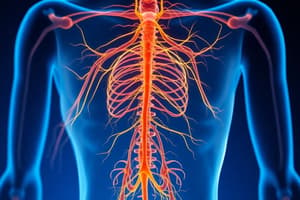Podcast
Questions and Answers
What is the primary function of the receptor in a somatic reflex arc?
What is the primary function of the receptor in a somatic reflex arc?
- To transmit motor signals to the effector
- To process sensory information in the spinal cord
- To connect the reflex arc to the brain for higher processing
- To detect stimuli and initiate the reflex (correct)
In which type of reflex does the signal not involve an interneuron?
In which type of reflex does the signal not involve an interneuron?
- Reciprocal inhibition reflex
- Stretch reflex (correct)
- Withdrawal reflex
- Cross extensor reflex
During reciprocal inhibition, which type of muscle is actively contracting?
During reciprocal inhibition, which type of muscle is actively contracting?
- Antagonist muscle
- Agonist muscle (correct)
- Synergist muscle
- Flexor muscle
What component of the somatic reflex arc carries sensory information from the receptor to the spinal cord?
What component of the somatic reflex arc carries sensory information from the receptor to the spinal cord?
Which type of reflex results in the contraction of extensor muscles on the opposite side of the stimulus?
Which type of reflex results in the contraction of extensor muscles on the opposite side of the stimulus?
What is the role of the ventral root in a somatic reflex arc?
What is the role of the ventral root in a somatic reflex arc?
Which structure is primarily involved in muscle stretch detection in reflexes?
Which structure is primarily involved in muscle stretch detection in reflexes?
In the integration center of a somatic reflex arc, what typically occurs in polysynaptic reflexes?
In the integration center of a somatic reflex arc, what typically occurs in polysynaptic reflexes?
Which of the following effects results from the activation of an effector in a reflex arc?
Which of the following effects results from the activation of an effector in a reflex arc?
What type of neuron carries signals away from the spinal cord to muscles in a reflex arc?
What type of neuron carries signals away from the spinal cord to muscles in a reflex arc?
Flashcards
Monosynaptic reflex
Monosynaptic reflex
A reflex arc that involves only one synapse between a sensory neuron and a motor neuron. It is a direct pathway that results in a quick and simple response.
Polysynaptic reflex
Polysynaptic reflex
A reflex arc that involves multiple synapses, including one or more interneurons. This allows for more complex integration and coordination.
Withdrawal reflex
Withdrawal reflex
A reflex that occurs when a painful stimulus is applied to the skin. It causes a withdrawal response, typically involving the flexion of a limb.
Stretch reflex
Stretch reflex
Signup and view all the flashcards
Cross extensor reflex
Cross extensor reflex
Signup and view all the flashcards
Reciprocal inhibition
Reciprocal inhibition
Signup and view all the flashcards
Receptor (Sensory Input)
Receptor (Sensory Input)
Signup and view all the flashcards
Afferent (Sensory) Pathway
Afferent (Sensory) Pathway
Signup and view all the flashcards
Integration Center
Integration Center
Signup and view all the flashcards
Efferent (Motor) Pathway
Efferent (Motor) Pathway
Signup and view all the flashcards
Study Notes
Somatic Reflex Arc Components
- Receptor (Sensory Input): Detects a stimulus (pain, stretch) triggering the reflex. It's located on a sensory peripheral nerve and receives afferent signals. The signal goes to the spinal cord via the dorsal root.
- Afferent (Sensory) Pathway: Carries sensory information from the receptor to the spinal cord. Components are peripheral nerve, spinal nerve, ramus, and dorsal root.
- Integration Center (Processing): Located in the spinal cord's gray matter. Signals are processed. Polysynaptic reflexes involve interneurons; monosynaptic reflexes involve direct connection to a motor neuron.
- Efferent (Motor) Pathway: Carries the response signal from the spinal cord to the effector. Components include ventral root, spinal nerve, ramus, plexus (if applicable), and peripheral nerve.
- Effector (Motor Output): The muscle or gland that responds to the stimulus. In somatic reflexes, the response is usually a muscle contraction.
Types of Reflexes
- Withdrawal/Flexor Reflex: Polysynaptic reflex triggered by pain or touch. The response is the contraction of the flexor muscles. Example: Pain reflex.
- Cross Extensor Reflex: Polysynaptic reflex that happens in conjunction with the withdrawal reflex. The response is the contraction of the extensor muscles on the opposite side of the stimulated area. Crucial for balance during the withdrawal reflex.
- Stretch Reflex: Monosynaptic reflex triggered by muscle stretch. The response is muscle contraction. Example: Knee-jerk reflex.
- Reciprocal Inhibition: When one muscle group contracts (agonist), its opposing muscle group relaxes (antagonist). This allows efficient movement.
Studying That Suits You
Use AI to generate personalized quizzes and flashcards to suit your learning preferences.




